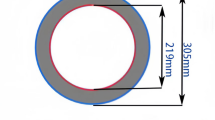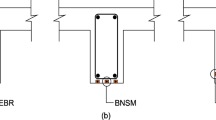Abstract
In this study, two types of special experiments are carried out to understand flexural compressive strength size effect of concrete members. The first type is an ordinary cylindrical specimen (CS) with a fully penetrated and vertically standing plate type notch at the mid-height of the specimen, which is loaded in compression at the top surface (e.g., in the parallel direction to the notch length). The second type is a general double cantilever beam (DCB), which is compression loaded in axial direction (e.g., in the parallel direction of the notch). For CS, an adequate notch length is taken from the experimental results obtained from the compressive strength experiment of various initial notch lengths. The trial tests to select the effective initial notch length show that CS with an initial notch length approximately greater than four times the maximum aggregate size fails without an additional increased load and in stable manner under Mode I failure mechanism. Therefore, the initial notch length to the maximum aggregate size ratio of 4.0 is used for all size specimens. For DCB, the eccentricity of loading points with respect to the axial axis of each cantilever and the initial notch length are varied. In both specimens, the compressive loads apply flexural compressive stresses on the crack tip region of the specimens. These two types of specimens fail by Mode I crack opening mechanism. By testing 3 geometrically proportional size specimens for CS and DCB, the experimental datum for flexural compression size effect of concrete are obtained. Using the obtained flexural compressive strength size effect datum, regression analyses are performed using Levenberg-Marquardt's least square method (LSM) to suggest new parameters for the modified size effect law (MSEL). The analysis results show that size effect is apparent for flexural compressive strength of specimens with an initial notch. For CS, the effect of initial notch length on flexural compressive strength size effect is apparent. For DCB, flexural compressive size effect is dependent on the eccentricity of loading points with respect to the axial axis of the cantilever beam. In other words, if DCB specimen is applied with greater tensile stress at the crack tip, the size effect of concrete becomes more distinct. The results show that the flexural compressive strength size effect of initial notch length variation of DCB exists but directly dependent on the loading location. This is due to the fact that the sizes of fracture process zone (FPZ) of all DCB specimens are similar regardless of the differences in the specimen slenderness ratio, but the flexural compressive and tensile stress combinations resulting in stress concentration at the crack tip region has direct effect on size effect of concrete members.
Similar content being viewed by others

References
Bazant, Z.P. (1984). Size effect in blunt fracture: concrete, rock, metal. Journal of Engineering Mechanics, ASCE 110(4), 518–535.
Bazant, Z.P. (1987). Fracture energy of heterogeneous material and similitude. SEM-RILEM International Conference on Fracture of Concrete and Rock 390–402.
Bazant, Z.P. (1993). Size effect in tensile and compressive quasibrittle failures. JCI International Workshop on Size Effect in Concrete Structures, 141–160.
Bazant, Z.P. and Kazemi, M.T. (1990). Determination of fracture energy, process zone length and brittleness number from size effect, with application to rock and concrete. International Journal of Fracture 44, 111–131.
Bazant, Z.P. and Xiang, Y. (1994). Compression Failure of Quasibrittle Materials and Size Effect. AMD Symposium of the American Society of Mechanical Engineers' Applied Mechanics Division, 185, Damage Mechanics in Composites, ASME Winter Annual Meeting, Chicago, Ill., Allen, D.H. and Ju, J.W., eds., 143–148.
Bazant, Z.P. and Xiang, Y. (1997). Size effect in compression fracture: splitting crack band propagation. Journal of Engineering Mechanics, ASCE 123(2), 162–172.
Benjamin, J.R. and Cornell, C.A. (1970). Probability, Statistics, and Decision for Civil Engineers. McGraw-Hill, New York, Section 4.3, 466–475.
Biot, M.A. (1965). Mechanics of Incremental Deformations. John Wiley & Sons, New York.
Blanks, R.F. and McNamara, C.C. (1935). Mass Concrete Tests in Large Cylinders. Journal of ACI, Presentation at the 31th Annual Convention, New York, 280–303.
Carpinteri, A., Chiaia, B. and Ferro, G. (1994). Multifractral Scaling Law for the Nominal Strength Variation of Concrete Structures. Size Effect in Concrete Structures, E &FN Spon, 409–416.
Cotterell, B. (1972). Brittle fracture in compression. International Journal of Fracture 8(2), 195–208.
Gonnerman, H.F. (1925). Effect of size and shape of test specimen on compressive strength of concrete. Proceedings, ASTM 25, 237–250.
IMSL, Library, Edition 8, IMSL, Inc.
Jenq, Y.S. and Shah, S.P. (1991). Features of mechanics of quasi-brittle crack propagation in concrete. International Journal of Fracture 51, 103–120.
Jansen, D.C. and Shah, S.P. (1997). Effect of length on compressive strain softening of concrete. Journal of Engineering Mechanics, ASCE 123(1), 25–35.
Karihaloo, B.L. (1992). Failure modes of longitudinally reinforced beams. In: Application of Fracture Mechanics to Reinforced Concrete (Edited by Carpinteri, A.), Elsevier Applied Science, London, 523–546.
Kim, J.K. and Eo, S.H. (1990). Size effect in concrete specimens with dissimilar initial cracks. Magazine of Concrete Research 42(153), 233–238.
Kim, J.K., Eo, S.H. and Park, H.K. (1989). Size Effect in Concrete Structures without Initial Crack. Fracture Mechanics: Application to Concrete, SP-118, ACI, Detroit, 179–196.
Kim, J.K., Yi, S.T. and Kim, J.H.J. (2001). Effect of specimen sizes on flexural compressive strength of concrete. ACI Structural Journal 98(3), 416–424.
Kim, J.K., Yi, S.T., Park, C.K. and Eo, S.H. (1999). Size effect on compressive strength of plain and spirally reinforced concrete cylinders. ACI Structural Journal 96(1), 88–94.
Kim, J.K., Yi, S.T. and Yang, E.I. (2000). Size effect on flexural compressive strength of concrete specimens. ACI Structural Journal 97(2), 291–296.
Markeset, G. and Hillerborg, A. (1995). Softening of concrete in compression localization and size effects. Cement and Concrete Research 25(4), 702–708.
Nemat-Nasser, S. and Obata, M. (1988). A microcrack model of dilatancy in brittle material. Journal of Applied Mechanics, ASME 55, 24–35.
Neville, A.M. (1956). The influence of size of concrete test cubes on mean strength and standard deviation. Magazine of Concrete Research 8(23), 101–110.
Neville, A.M. (1966). A general relation for strength of concrete specimens of different shape and size. Journal of ACI 63, 1095–1110.
Powers, T.C. (1956). Concrete Studies at the Bull Run Dam. City of Portland, Oregon, U.S. Department of the Interior, Bureau of Concrete Research.
Ruettgers, A. (1933). Mass concrete as affected by size of aggregate and related factors. Journal of ACI, Proceedings 30, 27–34.
Shah, S.P. and McGarry F.J. (1971). Griffith fracture criterion and concrete. Journal of Engineering Mechanics, ASCE 97, 1663–1676.
Yi, S.T., Kim, J.H.J. and Kim, J.K. (2002). Effect of specimen sizes on aci rectangular stress block for concrete flexural members. ACI Structural Journal 99(5), 701–708.
Author information
Authors and Affiliations
Rights and permissions
About this article
Cite this article
Kim, JH.J., Yi, ST. & Kim, JK. Size effect of concrete members applied with flexural compressive stresses. International Journal of Fracture 126, 79–102 (2004). https://doi.org/10.1023/B:frac.0000025300.66782.38
Issue Date:
DOI: https://doi.org/10.1023/B:frac.0000025300.66782.38



